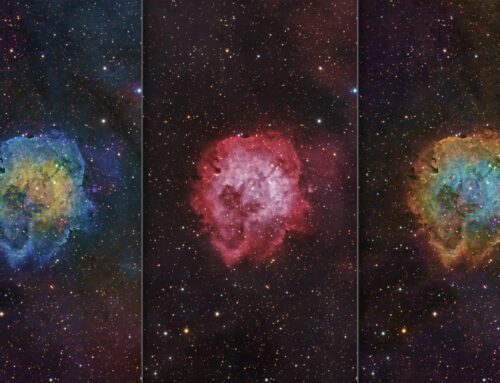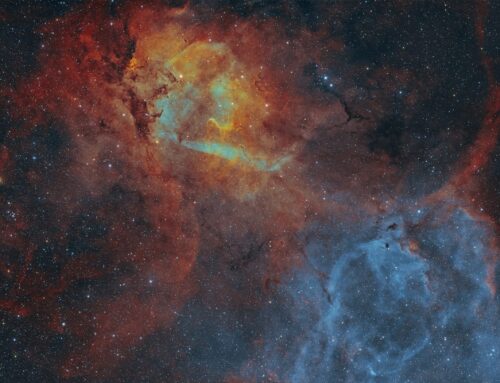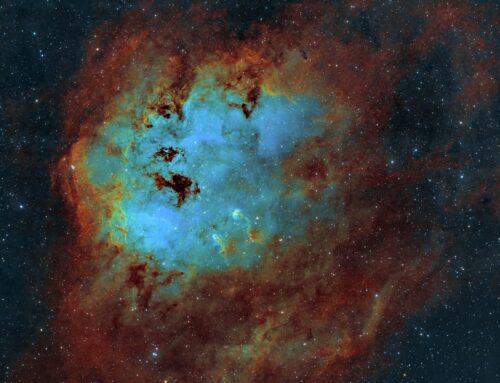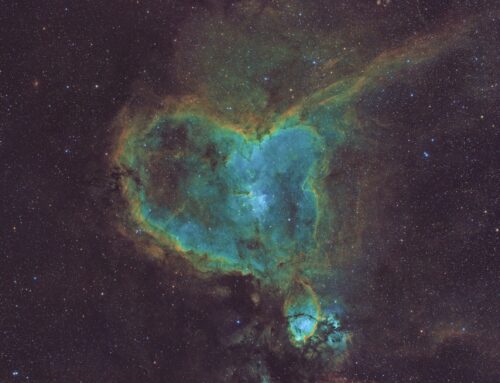Sh2-163
 Click image for full size version
Click image for full size version
November 11, 2025
This glowing patch of gas in Cassiopeia is Sh2-163 (pronounced ‘Sharpless 163’). It doesn’t seem to be imaged very often, certainly not at this focal length, although it does have nickname, the False Tulip nebula. I do see the similarity to the Tulip Nebula. The nebula’s reddish hue is mainly due to glowing hydrogen gas. Sh2-163 is about 10,000 light years away. To give you an idea of the size of this field of view on the sky, it is a little smaller than a half-Moon.
Tekkies:
Celestron 14″ EDGE HD telescope at f/11 (3,912 mm focal length) and QHY600M camera binned 2×2 with Optolong filters. Acquisition, focusing, and control of Paramount MX mount with N.I.N.A., TheSkyX and PHD2. Primalucelab low-profile 2″ Essato focuser and ARCO rotator. Guiding with PHD2. Equipment control with Primalucelab Eagle 4 Pro computer. Flats taken using a Primalucelab Giotto 430 mm flat panel. All pre-processing and processing in PixInsight. Acquired from my SkyShed in Guelph. Data acquired under variable Moon illumination with average or better transparency and average seeing September 19 – November 2, 2025.
16x 5m Red = 1hr 20m
17 x 5m Green = 1hr 25m
17 x 5m Blue = 1hr 25m
62 x 5m Ha = 5hr 10m
Total: 9hr 20m
Preprocessing: The WeightedBatchPreProcessing script was used to perform calibration, cosmetic correction, weighting, registration, local normalization, integration and Drizzle integration (1x, 0.9 drop shrink) of all frames.
RGB master: A master RGB image was made from the Red, Green and Blue masters using ChannelCombination in RGB mode.
Gradient Removal: DynamicBackgroundExtraction was used to remove gradients from the RGB and Ha masters.
Colour Calibration: ColorCalibration was used to calibrate the RGB master.
Deconvolution: BlurXterminator was applied to the two masters with Automatic psf , star sharpening set to 0.4, and non-stellar set to 0.5.
Star Removal: StarXterminator was used to remove the stars from both masters, with default settings, except Large Overlap was selected. Only the RGB stars-only image was retained.
Linear Noise Reduction: NoiseXterminator was applied to both masters with settings Amount=0.9 and Detail=0.25
Stretching: HistogramTransformation was applied to both masters to make pleasing images. Approximate background level after stretch was 0.09 for Ha and 0.10 for RGB.
Nonlinear Processing
Addition of Ha to RGB: Juergen Terpe‘s CombineHaWithRGB script was used to add the Ha into the RGB master.
Background Cleanup: Artifacts that were visible in the background regions of master image were repaired using the CloneStamp tool.
Nonlinear Noise Reduction: NoiseXterminator was used to reduce noise in the background areas of the HaRGB image with Amount=0.9 and Detail=0.15.
Re-stretch: HistogramTransformation was used to boost contrast by moving the dark point to the toe of the histogram and slightly decreasing the mid-point slider.
Contrast Enhancement: LocalHistogramEqualization was applied twice. A Contrast Limit of 1.5 and 1 iteration was used for each LHE application (scale 40, strength 0.25; scale 90, strength 0.2).
Sharpening: MultiscaleMedianTransform was applied. (Layers 2 – 4 with strengths of 0.06, 0.06, and 0.03, respectively), using a mask to select only the brightest parts of the image.
Contrast, Brightness and Colour: Background and nebula brightness, contrast, hue and saturation were adjusted in several iterations using Juergen Terpe‘s CreateHDRImage and SelectiveColorCorrection scripts, and CurvesTransformation, with masks as required.
Stars-only steps: HistogramTransformation was applied to the RGB stars-only image. A mask was made by using ChannelExtraction to extract the Lightness from the image. CurvesTransformation’s Saturation slider was used to boost colour in the stars through the star mask.
Star Restoration: PixelMath expression combine(starless, stars, op_screen()) was used to combine the starless HaRGB image with the RGB-stars-only image.
Final Steps: Background, nebula, and star brightness, contrast, hue, and saturation were adjusted in several iterations using CurvesTransformation with masks as required. ICCProfileTransformation (sRGB IEC61966-2.1; Relative Colorimetric with black point compensation) was applied prior to saving as a jpg. The finder chart was made using the FindingChart process.







Leave A Comment